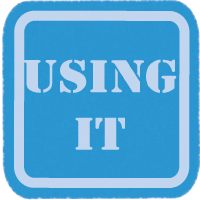 Transfer of Language & Problem Solving
Transfer of Language & Problem Solving
|
back to case study |
What is Transfer in Language learning?
Transfer is a key element during the Using It stage of the B-SLIM model. Transfer refers to the ability to use or apply what they have learned in new situations-contexts thereby ‘transferring’ their knowledge.
Why is transfer important?
Transfer is important in learning a second language because it shows that the learner will be able to use the knowledge they have of the language in order to fulfill a purpose in a new situation. It also demonstrates that the learner is able to use the language independently, spontaneously and creatively. Here, the student is moving from just “learning the language” toward “learning through the language”.
What can I do as a teacher to promote Transfer?
At the Using It stage of the B-SLIM model teachers need to start developing exercises and activities that promote transfer of the language. The goal here is for students to engage in activities from memory (or with minimal assistance) that require them to USE or apply what they have learned. In order to promote transfer teachers need to encourage tasks or activities that incorporate problem solving. Information gap activities and communicative activities should be used and more emphasis should be placed on fluency.
back to top
What role does problem solving have in language learning?
James Bourke provides several arguments supporting linguistic problem solving:
-
Problem-solving exploits the learners’ natural tendency to work things out. Studies in child language acquisition demonstrate that in language learning one cannot proceed very far without attempting to form hypotheses.
-
Problem-solving promotes what is known in the educational literature as significant learning, i.e. learning which is both self-discovered and meaningful. It enables learners to discover knowledge, internalize it, and subsequently reproduce it.
-
Problem-solving is an enjoyable activity when success can be achieved. It is a well established fact that learners learn like wildfire when they are interested and actively engaged in the learning process.
From James Bourke’s “In Praise of Linguistic Problem Solving” http://rel.sagepub.com/cgi/reprint/27/2/12
Classroom Ideas for Problem Solving
This teaching technique must be done orally on a regular basis before it could be done in print. Once students have experience with it, they will want to compose problems for the rest of the class. In this way they will need to write them down; writing is a means to a desired end not a boring end in itself!
Invite students to answer questions in oral or written form of the following nature. Use vocabulary from stories, poems, songs, dialogues, etc. in composing these problems. The first type is suitable to grade 7 ability. The final four may be introduced when the teacher feels that the students are ready to handle the questions and answers using only the target language.
a. mathematical: You have four pet doves. Your friend asks you to look after his five doves for the weekend while he visits his grandparents. How many doves do you have to look after this weekend?
b. generic words: dress, shirt, blouse, socks. How are these things alike? What do they have in common?
c. word lists: Your brother has just got his first job. He decides to move out on his own. What things will he need for his kitchen?
d. definitions: You have just met a Martian who asks you what "snow" is. How would you explain it to him? You have arrived on earth from another planet. You cannot see. You hear the word FOREST and ask an earthling to explain what that is. What does the earthling say?
e. moral decision-making: You see a child stealing some candy in a store. What could you do? What should you do?
f. scavenger hunt: Teacher identifies landmarks and other places within the school by creating a list of things to find. The list is given to students (individually or in pairs) and they must find the items on the list and answer a question at each location. Questions could be related to anything being studied and involve the creative, spontaneous use of language without supports.
back to top

Bourke, J.M. In Praise of Linguistic Problem Solving.
http://rel.sagepub.com/cgi/reprint/27/2/12


 Here, Lily is noticing that her mentor teacher is not giving the students a chance to GET or USE/APPLY what they are learning. The students are given information without an opportunity to interact with it. At this point the mentor teacher might benefit from allowing the students to start to “learn through the language” as opposed to just “learning about the language”. Lily recognizes this but is not sure what she would do in his place. In this section we will discuss the idea of TRANSFER as well as discuss ways to promote “learning through language”.
Here, Lily is noticing that her mentor teacher is not giving the students a chance to GET or USE/APPLY what they are learning. The students are given information without an opportunity to interact with it. At this point the mentor teacher might benefit from allowing the students to start to “learn through the language” as opposed to just “learning about the language”. Lily recognizes this but is not sure what she would do in his place. In this section we will discuss the idea of TRANSFER as well as discuss ways to promote “learning through language”.
